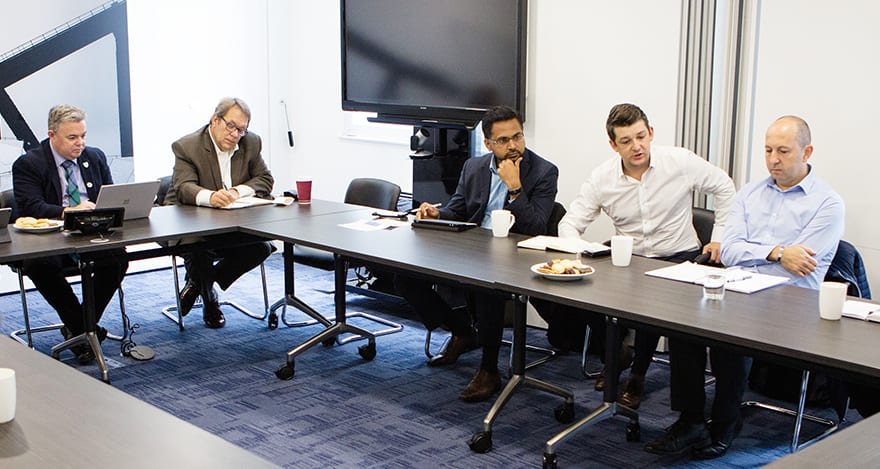For the second in our series of digital debates, in partnership with the Centre for Digital Built Britain, we look at how tier 1 constructors are rising to the challenge of BIM Level 2 and how it may change their role. Will Mann sat in on the discussion.
BIM Level 2 could transform the role of the tier 1 constructor. Potential benefits include not only capital delivery improvements, but also better asset data for clients and whole-life operational efficiencies. Modern methods of construction (MMC) are likely to become more widespread. But how will this impact tier 1 constructors? What can they do to make BIM Level 2 “business as usual” and what do they need to help deliver this?
Those were the issues discussed by the main contractors who gathered for the second in our series of digital debates, organised by CM, the Centre for Digital Built Britain (CDBB) and the Chartered Institute of Building (CIOB). CDBB will use the sessions, which will also involve consultants, facilities management (FM) providers, SMEs and suppliers in future round table sessions, to help understand how BIM is being adopted and inform the future policy agenda.
The debate was chaired by Terry Stocks, leader of the CDBB BIM Level 2 workstream, who began by asking the panel: “Why and when does a tier 1 deliver BIM projects? Because you want to or because the client asks?”
Aecom’s global director for project technologies, John Kizior, said: “To improve our margins and provide better outcomes for our clients. We do it to gain efficiencies and increase our bottom line. Digital transformation is the journey we must go on to start making business decisions based upon facts and data, and less on intuition and gut instinct. You want to mitigate risk. Why? Because you don’t want to lose money. So it all comes down to profitability.”
Andy Boutle, head of BIM at Kier Building, said clients still need to drive BIM. “Initially, we established a mechanism to assess incoming tenders and make an informed decision on whether to use BIM,” he explained. “But quite frankly, unless there is a client requirement, then the wheels come off.”

From left: David Philp (CDBB); John Kizior (Aecom); Senthil Arjunan (Interserve); Alex Jones (Murphy); Peter Vale (Tideway)
Willmott Dixon has a different mindset, according to Garry Fannon, head of digital. “We’ve decided we are going to do BIM regardless and use that data ourselves,” he said. “What we have realised is after Grenfell, we need better understanding of what we have built. So this data is actually quite useful. Our directors are now mandating it across the business. They see the bigger picture and they see the value of that data.”
“Does that mean you have developed your own internal information requirements?” asked Fiona Moore, BIM Level 2 programme manager at CDBB.
“Yes, we have a standard employer information requirement [EIR],” replied Fannon. “This is the data we provide to the customer, and we also keep it ourselves. So now we are building up data about maintainable assets and we are starting to formulate a data strategy.”
Interserve’s head of BIM and digital construction, Senthil Arjunan, noted clients’ BIM capabilities vary considerably. “They often haven’t got the right infrastructure and resources to manage the data that we hand over,” he said. “So depending on the project, we have got a tiered approach for BIM deployment from ‘BIM light’, through BIM Level 2, then a ‘BIM Level 2 stretch’.”
“Do other contractors have this ‘baseline’ approach to BIM, irrespective of whether a client asks for it?” David Philp, communications manager for the CDBB BIM Level 2 workstream, asked the wider panel.

Fiona Moore: “We do need to hear what businesses are doing to measure the outcomes of BIM and digital – the demonstrable benefits”
Sir Robert McAlpine applies a “sliding scale” of digital maturity on its work, said Nick Leach, strategic BIM manager. “There is a minimum that has to be hit, regardless of the project,” he explained.
“We try to address the foundations,” Boutle said. “Naming things consistently and organising them in an environment that is structured and consistent and repeatable. It is a challenge – with our own operational teams on site, with subcontractors, consultants – but we are trying to achieve that baseline and build from that upwards.”
A similar perspective came from the infrastructure sector. James Daniel, head of digital engineering for Skanska Infrastructure Services, said: “We need to get the basics right, a common data environment, an understanding of how you structure or store your data correctly, be it an order or a drawing.”
“One of our common problems is naming of documents,” said Peter Vale, engineering information manager at Tideway. “The water industry has suppliers working for different organisations and they all want it differently. That’s causing problems.”
Stephen Kennedy, head of digital and innovation at water specialist MWH Treatment, added: “The biggest challenge for us is in the absence of a client saying ‘this is what you need to do and this is the way you need to do it’. At the moment, what we are doing with BIM and digital is predominantly for our own efficiency.”
“So does BIM cost money to deploy?” asked Stocks. “Is there a surcharge on BIM projects?”
“Ten years ago, if BIM was on the contract, another £100,000 was added on, and the money businesses were investing was then passed on to the client,” said Daniel. “That has gone now. With the contracts we have, BIM ‘is business as usual’.”

David Philp, CDBB: “There will be a fundamental change in what tier 1s look like, not just due to Level 2 BIM but other digital technologies.”
Stocks asked if clients understood the benefits of BIM during the procurement of the tier 1 contractors. “Generally, the message I’m hearing is ‘no’,” he said.
But Metropolitan Police head of BIM Javed Edahtally said clients have difficulty engaging their own teams on BIM. “I was meeting with consultants recently and said it would be really useful if we gave you what information we wanted at what RIBA stage and to what level of granularity,” he explained. “They said, ‘Yes that would be great.’ So, I took a document out of my bag and said, ‘Here you go’, and they looked really worried.”
“Clients face the same challenges we do in terms of BIM engagement,” observed Boutle. “We have one client which is really intelligent in terms of BIM. But they still can’t get their FM team to say what the need is.”
Alex Jones, head of BIM and digital construction at Murphy, echoed this. “The ingredient missing is FM,” he said. “We are seeing a huge movement in BIM within contracting, but not in FM. I still see them walking around with clipboards.”
“But it isn’t actually that difficult,” said Edahtally, “because if you have an asset management policy and strategy, you should know what information you need.”
“That is the whole point of Soft Landings,” said Jones. “Use Soft Landings from the beginning so you understand the end-user requirements.”
“Soft Landings was one of the intentions of BIM Level 2 and for whatever reason it seems like it hasn’t happened,” said Boutle.

John Kizior, Aecom: “Tier 1s are becoming data aggregators whether they want to or not.”
“One of the challenges with water companies is the transfer of data from the project information model into the asset information model,” said Kennedy. “It is very difficult finding out what the operators actually want. The owners have to understand how their assets are operated then define that back to us.”
“This goes back to the organisational information requirements [OIR],” said Stocks. “If the client has an OIR that sets their strategic direction for a business, the constructor can understand the asset information requirements [AIR] and then the EIRs just contractualise it through project delivery.”
“We have got a consulting business within Interserve which is now looking at helping clients with their OIRs and AIRs,” said Arjunan. “They do the hand-holding with the clients and we get better EIRs as a result.”
The discussion moved on to whether constructors can use the data they collect to help with asset management strategies. Kizior said Aecom has set up a business to provide that service. “We engage with the client, we take their asset data and marry it to their systems,” he explained. “We are showing them how to use that information to run their facilities and their assets better. There is a wonderful opportunity here. You just have to show clients the benefits.”
“So I am hearing that the basic BIM service is free – business as usual – but where constructors can make money is the additional services?” asked Stocks.
Edahtally agreed there was a gap in the market for this. “We can’t maintain our own information so we need a capable supply chain to do it on our behalf,” he said. “ We have engaged with NG Bailey who can update model data and other digital information in a manner that is consistent with how we operate as an organisation.”
Daniel said that Skanska is working with highways clients to organise their data and plan their maintenance strategy their maintenance strategy. “On longer-term contracts, we are writing their requirements for free,” he said. “One client gave us a 13TB hard drive with the whole county mapped. So we started to drill down into it and we said, ‘Well actually, we can tell you how to manage your potholes and your water gulleys for the next five years’. And they said, ‘That sounds really interesting!’”
“It would be interesting to read the case study on that,” said Vale. “We need BIM case studies that can be shared, or we can’t improve. Hold on to the specifics that you need, but if we don’t share knowledge of what works, we can’t create that wider digital cultural change across the industry.”
“We do need to hear what businesses are doing to measure the outcomes of BIM and digital – the demonstrable benefits,” added Moore.
Top image, clockwise from top left: David Philp (CDBB); Senthil Arjunan (Interserve); Garry Fannon (Willmott Dixon); Alex Jones (Murphy) with Senthil Arjunan (Interserve); Andy Boutle (Kier); Terry Stocks (CDBB)
10 action points for constructors from the debate
- Better information management is essential post Grenfell – constructors need to know what they have built and to be able to hand over data to the employer to support their asset.
- Exploitation of data can help constructors add value to their service delivery offering.
- Where clients do not request BIM, a “baseline’ digital service should be provided.
- Current poor practices at handover can be addressed through better BIM and Soft Landings processes.
- Greater and earlier engagement of FM and operational teams is necessary to help clients understand BIM’s potential for improving their asset management.
- Soft Landings is rarely used to its full extent and a champion in that role can help when testing a design for maintainability and handing over assets into the operational phase.
- Digital skills shortfalls can be partly addressed through recruiting outside the industry, for example, app developers.
- Training internally and of suppliers needs standardising, BIM accreditation should be considered to align outcomes across the industry.
- Use of 3D models, visualisations and virtual reality can help engage both suppliers and clients with digital’s potential.
- Better bench-marking of BIM benefits and clear case studies are needed to present a more convincing business case for the technology.
Key findings: Constructors and BIM Level 2
“Tier 1 constructors have taken up the challenge and are adapting to BIM Level 2. However, they are using it within their traditional approaches – inward-facing, with direction to their supply chains rather than supporting clients.
“They have reached a level of proficiency where they can now offer BIM Level 2 ‘base’ outputs with no additional cost to the contract, providing the client includes the Level 2 outcomes required at tender stage.
“They view their immediate role within a digital environment as an integrator between suppliers, mapping the progress of works.
“However, as manufactured solutions and standard platform designs become more mainstream, the traditional role of the tier 1 constructor could change significantly.”
Terry Stocks, leader of the CDBB BIM Level 2 Workstream













